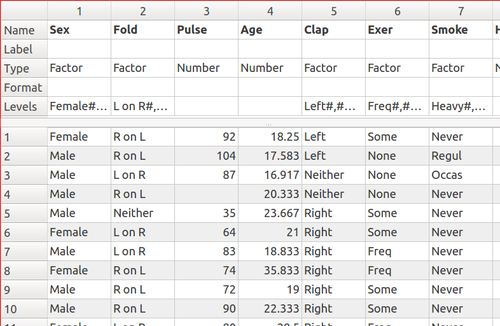Use the following quiz questions to check your understanding of how variables are used in statistics.
Viewing a dataset

Spreadsheet displaying 7 variables for 10 individuals
The screenprint at right shows data, as viewed in a spreadsheet, collected from a group of students in Adelaide, Australia. The following variables are included:
- Sex: Male, Female
- Fold: “Fold your arms! Which is on top”: R on L, L on R, Neither
- Pulse: pulse rate of student (beats per minute)
- Age: age of the student in years
- Clap: "Clap your hands! Which hand is on top?": Right, Left, Neither
- Exer: how often the student exercises: Freq (frequently), Some, None
- Smoke: how much the student smokes: Heavy, Regul (regularly), Occas (occasionally), Never
- The variable in column 3 in the dataset is Pulse.
- The value of "Exer" for observation #9 is Some.
- Observation #7 is male, is almost 19 years old, has never smoked and has a pulse of 83.
For the following questions as soon as you have indicated your response, the question is scored and feedback is provided. As feedback is provided for each option, you may find it useful to try each of the responses (both correct and incorrect) to read the feedback, as a way to better understand the concept.
Categorical vs. quantitative variables
A survey of library patrons asked participants for various information. For each of the survey questions below indicate whether the type of variable is categorical or quantitative.
- Age (<18, 18-30, 31-50, 51-70, >70)
- categorical
- That's correct. When the ages are grouped into ranges, as is the case here, the variable is categorical.
- quantitative
- That's not quite right. If the survey response was the exact age of the person, the variable would be quantitative, but as the ages are grouped into ranges, the variable is categorical in nature.
- What is your main occupation? (student, public employee, private employee, retired)
- categorical
- That's correct. The 4 possible responses are labels which group the respondents into 4 categories.
- quantitative
- That's not quite right. The 4 possible responses are labels which group the respondents into 4 categories.
- Number of people in your household?
- categorical
- That's not quite right. The responses to this question are numerical values, not merely labels. Although not every number is possible (e.g., 0 is not possible and 100 is very unlikely), it is reasonable to do arithmetic operations on the collection of participant responses.
- quantitative
- That's correct. The responses are numerical values for which arithmetic operations make sense.
- About how many books or media do you typically have on loan from the library at any given time?
- categorical
- That's not quite right. The responses to this question are numerical values. It is reasonable to do arithmetic operations on the resulting data, even though the numbers may be estimates and averages.
- quantitative
- That's correct. The responses to this question are numerical values for which arithmetic operations make sense.
- Have you ever attended a program put on by the library staff? (1=yes, 2=no)
- categorical
- That's correct. The two possible responses group the respondents into two categories.
- quantitative
- That's not quite right. Although the coded responses in the dataset are numbers, these numbers only serve to indicate in which of the categories the respondent belongs.
